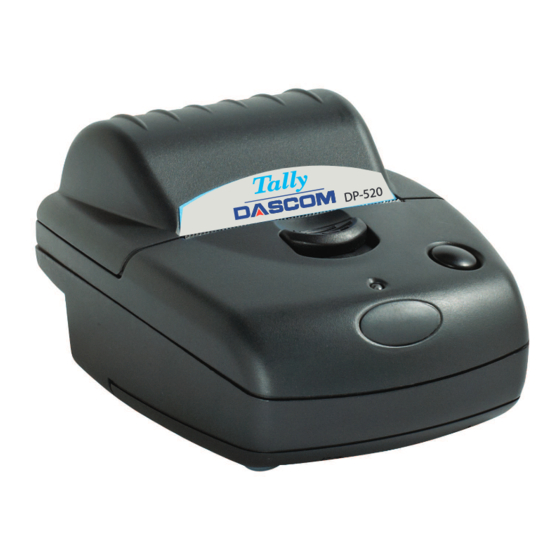Dascom DP-520 Panduan Operator - Halaman 13
Jelajahi secara online atau unduh pdf Panduan Operator untuk Printer Dascom DP-520. Dascom DP-520 19 halaman. Wired printer
Juga untuk Dascom DP-520: Panduan Pengguna (12 halaman), Petunjuk Penyiapan Cepat (2 halaman), Petunjuk Penyiapan Cepat (2 halaman)

RS-232 SERIAL INTERFACE (APPLIES TO ALL MODELS)
All DP-510 and DP-520 printers have an industry standard RS-232 interface. The default parameters are 9600 baud,
8 data bits, 1 stop bit and no parity. Other baud rates can be programmed by control codes, or by using a setup
utility. Contact Dascom Technical Support for information regarding the setup utility.
Serial data is expected in standard RS-232C format with -12V meaning 'mark' or '1' and +12V a logical '0', with
reference to the common ground. The serial data output line, TxD, transmits XON/XOFF and status information to
the host at the same Baud rate and in the same format as the serial data input. The hardware busy line is true
(nominal -12V) when busy. Both serial output lines will relax to approximately 0V when the printer is in sleep
mode, and the user must allow a short period after awakening before relying on the values of these signals.
Some host equipment use a constant space condition (+12V) to indicate a reset condition or wait state. Some battery
powered host equipment present the same output signal when they go to sleep. The printer can be set to ignore this
condition as detailed in the Programmer's Manual, but even then this type of host behavior may result in one or
more spurious characters being received and printed, or the printer may be prevented from going to sleep.
IrDA INTERFACE (APPLIES TO DP-510 IRDA AND DP-520 IRDA ONLY)
IrDA models feature an Infra-Red window on the front of the body. It includes special hardware which wakes the
printer when any Infra-Red activity is detected. In order to reduce the occurrence of 'false triggers', the sensitivity of
this wake-up sensor is reduced. It may be necessary to bring the host IrDA device fairly close to the printer before it
will wake up.
Once awake, the printer will respond to communications from an IrDA compliant primary device. The printer
supports 'point-to-point' applications (i.e. one primary device and one secondary device). It operates only as a
secondary device, and cannot initiate a link between devices.
Once a link is established then the printer shows a red indicator through the IR window on the front. The link will
continue as long as the devices are maintained in line-of-sight and within operating range. While a link is
maintained, data may be exchanged freely between the two devices.
The protocols supported are as follows: IrPHY V1.0, IrLAP, IrLMP, IAS, TinyTP and IrCOMM 9-wire.
BLUETOOTH INTERFACE (APPLIES TO DP-510 BLUETOOTH AND DP-520 BLUETOOTH ONLY)
Bluetooth models include a class 2 implementation of the Panasonic PAN1440 module, which is Bluetooth 1.1
compliant, and is certified to EN 300 328. The protocols and profiles supported are as follows: LM, L2CAP,
RFCOMM, SDP, TCS, SPP (Serial Port Profile).
The detail of how to establish a Bluetooth link and transfer data will vary greatly depending on the primary host
device. However, the process will generally involve the following stages:
i.
Discovery of Bluetooth devices;
ii.
Discovery of the printer's services;
iii.
Selection of the Serial Port Profile;
iv.
It may be necessary to Pair with the printer;
v.
Connecting to the printer.
Note. The PIN for making a secure connection to the printer is pre-set to "1234".
Usually the Bluetooth link is maintained for as long as the devices are within operating range. While the link is
active, data may be exchanged freely between the two devices. Occasionally the link may be lost, in which case the
user should re-initiate the link from the primary host as described above.
INTERFACE DETAILS
9
